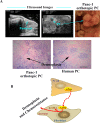Human pancreatic cancer progression: an anarchy among CCN-siblings
- PMID: 27541366
- PMCID: PMC5055500
- DOI: 10.1007/s12079-016-0343-9
Human pancreatic cancer progression: an anarchy among CCN-siblings
Abstract
Decades of basic and translational studies have identified the mechanisms by which pancreatic cancer cells use molecular pathways to hijack the normal homeostasis of the pancreas, promoting pancreatic cancer initiation, progression, and metastasis, as well as drug resistance. These molecular pathways were explored to develop targeted therapies to prevent or cure this fatal disease. Regrettably, the studies found that majority of the molecular events that dictate carcinogenic growth in the pancreas are non-actionable (potential non-responder groups of targeted therapy). In this review we discuss exciting discoveries on CCN-siblings that reveal how CCN-family members contribute to the different aspects of the development of pancreatic cancer with special emphasis on therapy.
Keywords: CCN1; CCN2; CCN3; CCN4; CCN5; Genetically engineered mice model; Pancreatic cancer; Patient derived xenograft.
Conflict of interest statement
Compliance with ethical standards Conflicts of interest The authors declare no conflict of interest.
Figures




References
Grants and funding
LinkOut - more resources
Full Text Sources
Other Literature Sources
Miscellaneous

